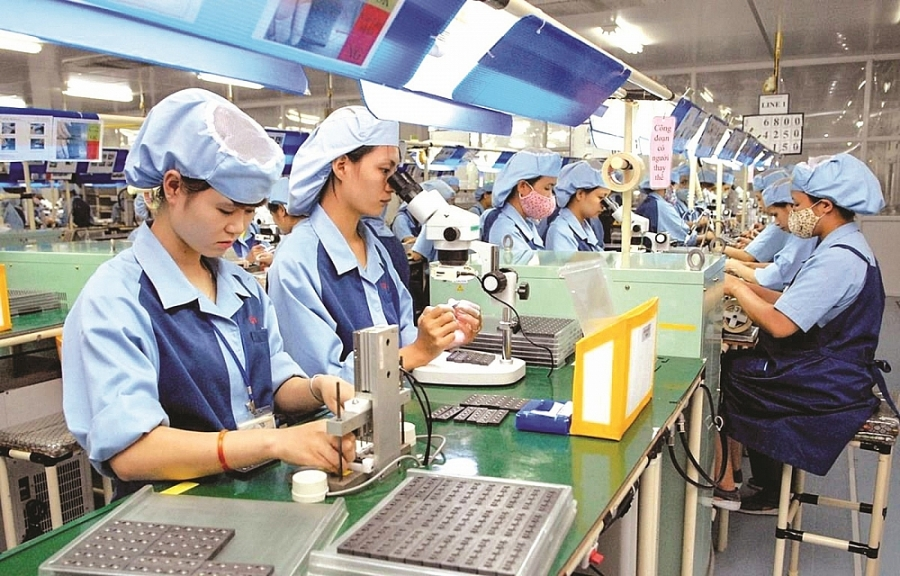
Mr. Vũ Bá Phú, Director General of the Trade Promotion Department (under the Ministry of Industry and Trade), emphasizes that foreign direct investment (FDI) plays a vital role in Vietnam’s supporting‑industry sector.
Currently, Vietnam has around 5,000 supporting‑industry firms, of which approximately 1,700 are FDI enterprises, accounting for 40% of the total.
A substantial domestic market gap remains
In 2024, the processing–manufacturing sector alone attracted more than USD 25.5 billion in new registered FDI, representing nearly 67% of total FDI in Vietnam. Sectors such as electronic components, precision machinery, and auto‑motorcycle parts—especially for electric vehicles—are receiving considerable attention and support from multinational corporations and FDI companies.
Nonetheless, the domestic supporting‑industry landscape remains weak. Nearly 88% of local firms are small and medium‑sized enterprises (SMEs) often using outdated equipment and lacking quality standards. Only about 10% implement automation, and fewer than 20% hold ISO certification or apply modern management models such as 5S, Lean, or Total Quality Management.
Consequently, most local companies are confined to low‑level subcontracting and struggle to meet high‑standard, large‑scale orders from lead firms.
As a result, localization remains low across several key industries. The automobile sector has yet to reach the 40% localization goal, while electronics—despite the presence of major global players—still rely heavily on imported components. Localization rates stand at about 45–50% for textiles and footwear, 15–20% for mechanical manufacturing, and 5–20% for automotive assembly.
“Of the more than 6,000 supporting‑industry companies active in Vietnam, only about 10% currently meet domestic production needs for components and parts,” Mr. Phú comments.
This reality highlights a significant gap in the industrial ecosystem and underscores the urgent need for deep‑investment strategies to enhance domestic value‑added production.
Meanwhile, investment promotion efforts for the supporting‑industry sector remain generalized, lacking specialization and effective mechanisms to link Vietnamese firms with strategic investors—especially in terms of technology transfer and global production standards.
Expectations from Japanese businesses
Amid escalating U.S.–China trade tensions, a 2024 survey by the Japan External Trade Organization (JETRO) revealed a clear shift of production from China to ASEAN, with Vietnam emerging as a key destination. Japanese firms are increasingly optimistic about Vietnam’s domestic market and intend to boost exports.
Mr. Takahiro Kono, Project Director of JETRO in Hanoi, notes the growing interest of Japanese enterprises in Vietnam, as seen in the retail sector accounting for the largest share of newly approved investment projects.
Moreover, Japanese firms are expanding their manufacturing functions in Vietnam for export purposes. In supply chains, the ability to procure locally has become increasingly critical.
The survey indicates that 50.9% of Japanese firms in Vietnam wish to expand domestic procurement—the highest rate in ASEAN—and up by 7.7 percentage points from the previous year, reflecting a stronger localization intent.
However, current localization rates remain low—36.6% overall, with only 15.7% of procurement coming from Vietnamese enterprises.
To promote domestic sourcing, identifying capable Vietnamese suppliers is crucial. Major challenges include insufficient quality and technical standards among local suppliers.
With nearly 30 years of experience manufacturing aerospace components in Japan before investing in Vietnam, Mr. Masaru Onaga, CEO of Onaga Vietnam, cites frequent schedule changes by local companies that derail planned progress.
He also mentions difficulties in conveying the importance of standards like AS9100: “Translated documents from Japanese to Vietnamese often contain subtle differences in meaning that create confusion.” He proposes an official English‑to‑Vietnamese translation to better communicate AS9100 requirements.
Mr. Onaga also requests support—both from Vietnamese firms and the government—for costs associated with obtaining AS9100 certification, which is essential for producing aerospace and semiconductor components.
He further proposes that the Vietnamese government simplify and standardize administrative procedures—unifying the format and templates for documentation and providing clear guidance to avoid repeated submissions or delays.
“The governments of both countries should collaborate to develop standardized forms and procedures so investors know exactly where to start and what to do. That builds trust among Japanese businesses,” Mr. Onaga says.
He also calls for consistent decisions across administrative levels, preventing situations where documentation is approved by one officer but later rejected by a superior.
Additionally, he advocates for checklist tools that help investors identify omissions or errors in submissions, and simplified administrative processes so that Japanese firms can handle procedures independently, without relying on consulting firms.
Source: vneconomy.vn




